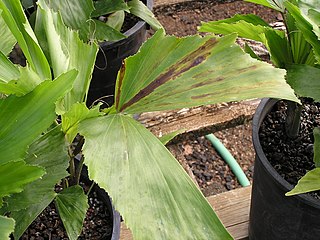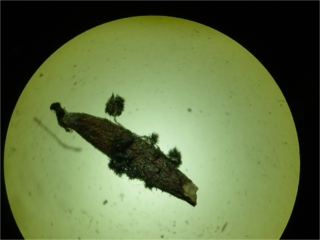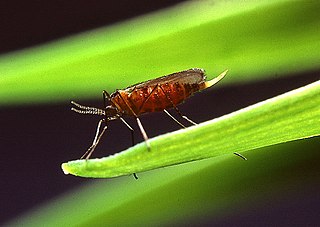
Acidovorax is a genus of within the family Comamonadaceae. The genus contains some plant pathogens, such as Acidovorax avenae, which causes bacterial fruit blotch on cucurbit crops. Other Acidovorax sp. perform Fe(II) oxidation in anaerobic environments, forming iron minerals in the soil.
Spot blotch is a leaf disease of wheat caused by Cochliobolus sativus. Cochliobolus sativus also infects other plant parts and in conjunction with other pathogens causes common root rot and black point.

The fungal genus Pyrenophora includes 108 species, including the following plant pathogenic species: Pyrenophora teres, Pyrenophora graminea and Pyrenophora tritici-repentis.
Gaeumannomyces graminis var. avenae is a plant pathogen.

Pyrenophora seminiperda is a minor plant pathogen that causes leaf spots on many grasses. It is an important generalist grass seed pathogen which causes visible cylindrical masses of black fungal hyphae (stromata) to grow from infected seeds. Hence the common name "black fingers of death"
Pyrenophora chaetomioides is a plant pathogen that affects oats.
Pyrenophora teres f. maculata is a plant pathogen causing spot form net blotch in barley.
Pyrenophora teres f. teres is a plant pathogen causing net form net blotch in barley.

Puccinia coronata is a plant pathogen and causal agent of oat and barley crown rust. The pathogen occurs worldwide, infecting both wild and cultivated oats. Crown rust poses a threat to barley production, because the first infections in barley occur early in the season from local inoculum. Crown rusts have evolved many different physiological races within different species in response to host resistance. Each pathogenic race can attack a specific line of plants within the species typical host. For example, there are over 290 races of P. coronata. Crops with resistant phenotypes are often released, but within a few years virulent races have arisen and P. coronata can infect them.
Erysiphe graminis f. sp. avenae is a plant pathogen of oats.

Heterodera avenae, the cereal cyst nematode or European cyst nematode, is a plant pathogen and an obligate parasite of cereal crops including barley, oats, wheat and rye. Cereal crops infected with this nematode are more susceptible to infection by fungal diseases such as rhizoctonia root rot.
Cereal cyst nematode (CCN) is a plant pest caused by Heterodera avenae, Heterodera bifenestra, Heterodera hordecalis, Heterodera latipons, and Heterodera gotland in the following hosts: Avena sativa, Hordeum vulgare, Secale cereale, Triticum aestivum, and × Triticosecale.
Aphelenchus avenae is a mycophagous nematode capable of feeding on plant tissue in culture. It is a nematode commonly found in the soil, known to primarily feed on fungi. However, there have been instances where Aphelenchus has been observed in healthy plant tissue, although there is currently no evidence suggesting that it causes harm to higher plants. Due to its ease of cultivation on fungi, Aphelenchus is considered a suitable organism for experimental purposes. Within the Aphelenchus genus, several species have been identified, but experts are uncertain whether these represent distinct species or if A. avenae is simply a morphologically variable species. In the Netherlands, only female specimens of Aphelenchus have been discovered, while in southern Europe, males are quite common. Interestingly, if we cultivate Dutch material at higher temperatures, males also appear in the population.

Mayetiola are a genus of flies from the family Cecidomyiidae. Most species are pests of cereal crops.
Cymindis avenae is a species of ground beetle in the subfamily Harpalinae. It was described by J. R. Sahlberg in 1908.

Aspergillomarasmine A is an polyamino acid naturally produced by the mold Aspergillus versicolor. The substance has been reported to inhibit two antibiotic resistance carbapenemase proteins in bacteria, New Delhi metallo-beta-lactamase 1 (NDM-1) and Verona integron-encoded metallo-beta-lactamase (VIM-2), and make those antibiotic-resistant bacteria susceptible to antibiotics. Aspergillomarasmine A is toxic to leaves of barley and other plants, being termed as "Toxin C" when produced by Pyrenophora teres.

The English grain aphid is an aphid in the superfamily Aphidoidea in the order Hemiptera. It is a true bug and sucks sap from plants. It lives on grasses, sedge and rushes and can be a significant pest of cereals.

Prochloraz, brand name Sportak, is an imidazole fungicide that was introduced in 1978 and is widely used in Europe, Australia, Asia, and South America within gardening and agriculture to control the growth of fungi. It is not registered for use in the United States. Similarly to other azole fungicides, prochloraz is an inhibitor of the enzyme lanosterol 14α-demethylase (CYP51A1), which is necessary for the production of ergosterol – an essential component of the fungal cell membrane – from lanosterol. The agent is a broad-spectrum, protective and curative fungicide, effective against Alternaria spp., Botrytis spp., Erysiphe spp., Helminthosporium spp., Fusarium spp., Pseudocerosporella spp., Pyrenophora spp., Rhynchosporium spp., and Septoria spp.
Spermospora avenae or red leather leaf is a fungal plant pathogen of Avena sativa.








